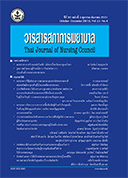Gaps in Nutrition Care Process by a Multidisciplinary Team
Keywords:
nutritional care team, nutritional care system improvement, qualitative researchAbstract
Abstract
1) To describe the process in the nutritional care system; and 2) to explore gaps in
nutritional care and approaches to nutritional care system improvement in a tertiary hospital.
Design: Qualitative research.
Methodology: Nine informants in the nutrition care team were recruited to form a
focus group, consisting of 2 physicians, 2 nurses, 3 dietitians, and 2 pharmacists. Data were
collected through focus group discussion and in-depth interviews. The data were then
analysed using content analysis.
Results: The implementation of the hospital’s nutrition care system consisted of three
parts: 1) the structure; 2) the process, comprising nutritional assessment, coordination,
referral, and nutritional therapy and monitoring; and 3) the outcome of the process. The gaps
in the nutritional care system, and hence the necessary approaches to its improvement, were
related to: 1) the staff’s work overload; and 2) disproportion between manpower and
increased workload. Possible solutions included adjustment of the work system to achieve a
better balance between the work scope, workload, and current manpower, which would result
in more effcient teamwork.
Recommendations: In tertiary hospitals, where the number of patients is usually large
and the complexity of the diseases is high, appropriate and systematic management of nutritional
care is extremely important. Proper nutritional therapy conducted by a multidisciplinary team
is required. However, as no clear standard has been established, the administrationof nutritional
care varies amongst healthcare practitioners. It is necessary, therefore, that hospitals clearly
defne the work scope, workload, policies, and career paths for their personnel.
Downloads
References
1.Center SPDM. annual report 2015-2017 [cited 2018. Available from:https://intra9.rama.mahidol.ac.th/sdmc/administrator/sites/default/fles/public/PDF/AnnualReport%202558%20-%20
60-02%20%281%29.jpg.
2. Barker LA, Gout BS, Crowe TC. Hospital malnutrition: prevalence, identifcation and impact on patients and the healthcare system. IJERGQ.2011;8(2):514-27.
3. O’Flynn J, Peake H, Hickson M, Foster D, Frost G.The prevalence of malnutrition in hospitals can be
reduced: results from three consecutive crosssectional studies.Clin Nutr. 2005;24(6):1078-88.
4. Reserve WIAR. system 2017 [cited 2017 25 March 2017]. Available from: https://www.businessdictionary.com/defnition/system.html.
5. Tappenden KA, Quatrara B, Parkhurst ML, Malone AM, Fanjiang G, Ziegler TR. Critical role of nutrition in improving quality of care: an interdisciplinary call to action to address adult hospital malnutrition. JAND. 2013;113(9):1219-37.
6. Gurzick M, Kesten KS. The impact of clinical nurse specialists on clinical pathways in the application of evidence-based practice. J Prof Nurs. 2010;26 (1):42-8.
7.Hvas C, Farrer K, Donaldson E, Blackett B, Lloyd H, Forde C, et al. Quality and safety impact on the
provision of parenteral nutrition through introduction of a nutrition support team. EJCN. 2014;68(12):1294.
8. Kennedy JF, Nightingale JM. Cost savings of an adult hospital nutrition support team. Nutrition. 2005;21(11):1127-33.
9.Bhagavatula M, Tuthill D. The role of a hospital Nutrition Support Team. J.Paed. 2011;21(9):389-93.
10.Tangvik RJ, Tell GS, Eisman JA, Guttormsen AB,Henriksen A, Nilsen RM, et al. The nutritional
strategy: four questions predict morbidity, mortality and health care costs.j.clnu. 2014;33(4):634-41.
11.Shang E, Hasenberg T, Schlegel B, Sterchi A,Schindler K, Druml W, et al. An European survey of structure and organisation of nutrition support teams in Germany, Austria and Switzerland. J Clnu. 2005;24(6):1005-13.
12.Nightingale J. Nutrition support teams: how they work, are set up and maintained. Frontline Gastroenterology. 2010:flgastro224.
13.K C. Study of gaps in diagnosis and treatment of risk nutrition in the hospital 2015 [Available from:
https://www.hitap.net/documents/18954.
14.Donabedian A, Wheeler JR, Wyszewianski L.Quality, cost, and health: an integrative model. Medical care. 1982:975-92.
15.Arends J, Bachmann P, Baracos V, Barthelemy N,Bertz H, Bozzetti F, et al. ESPEN guidelines on nutrition in cancer patients.j.clnu. 2017;36(1):11-48.








